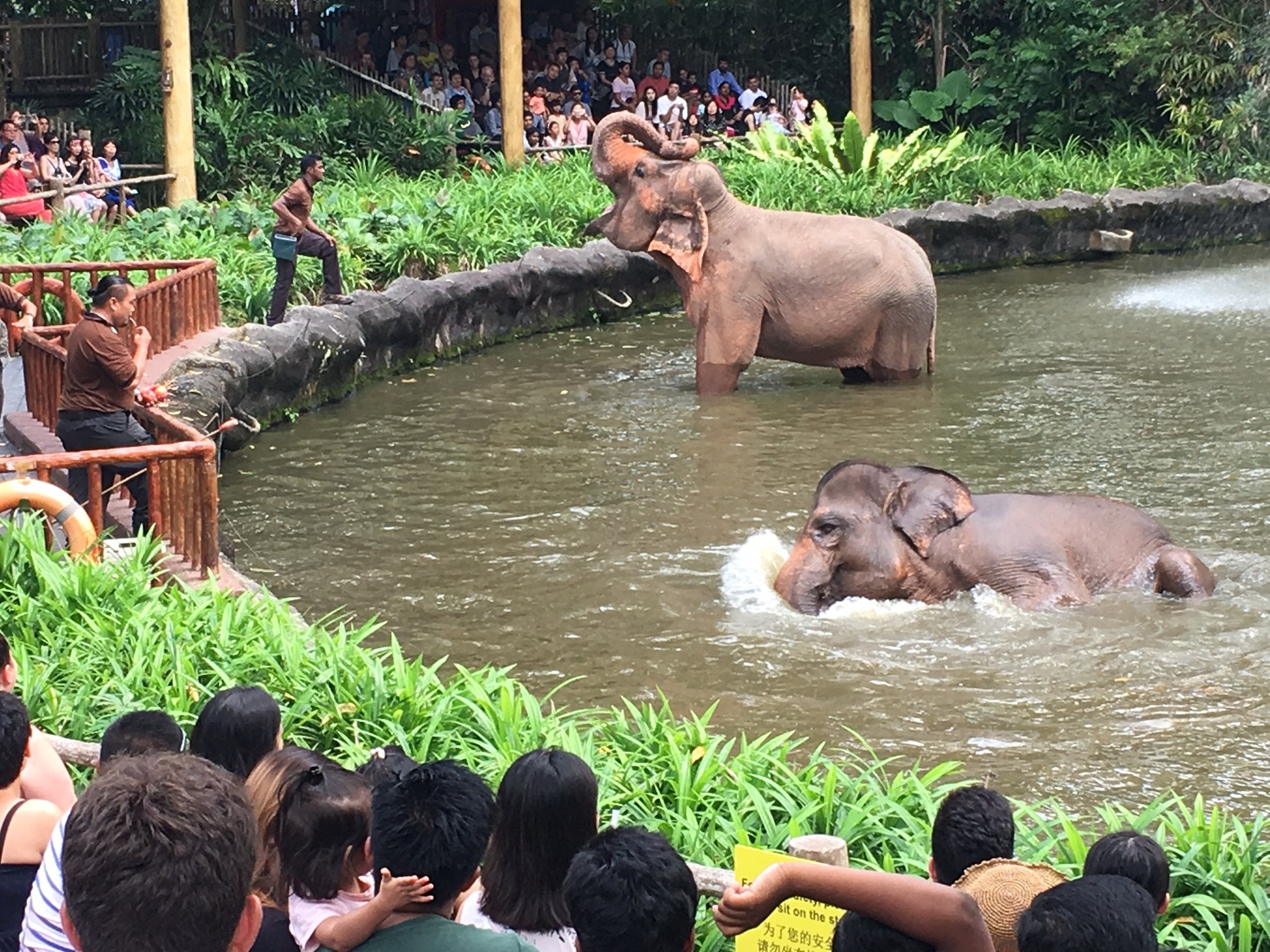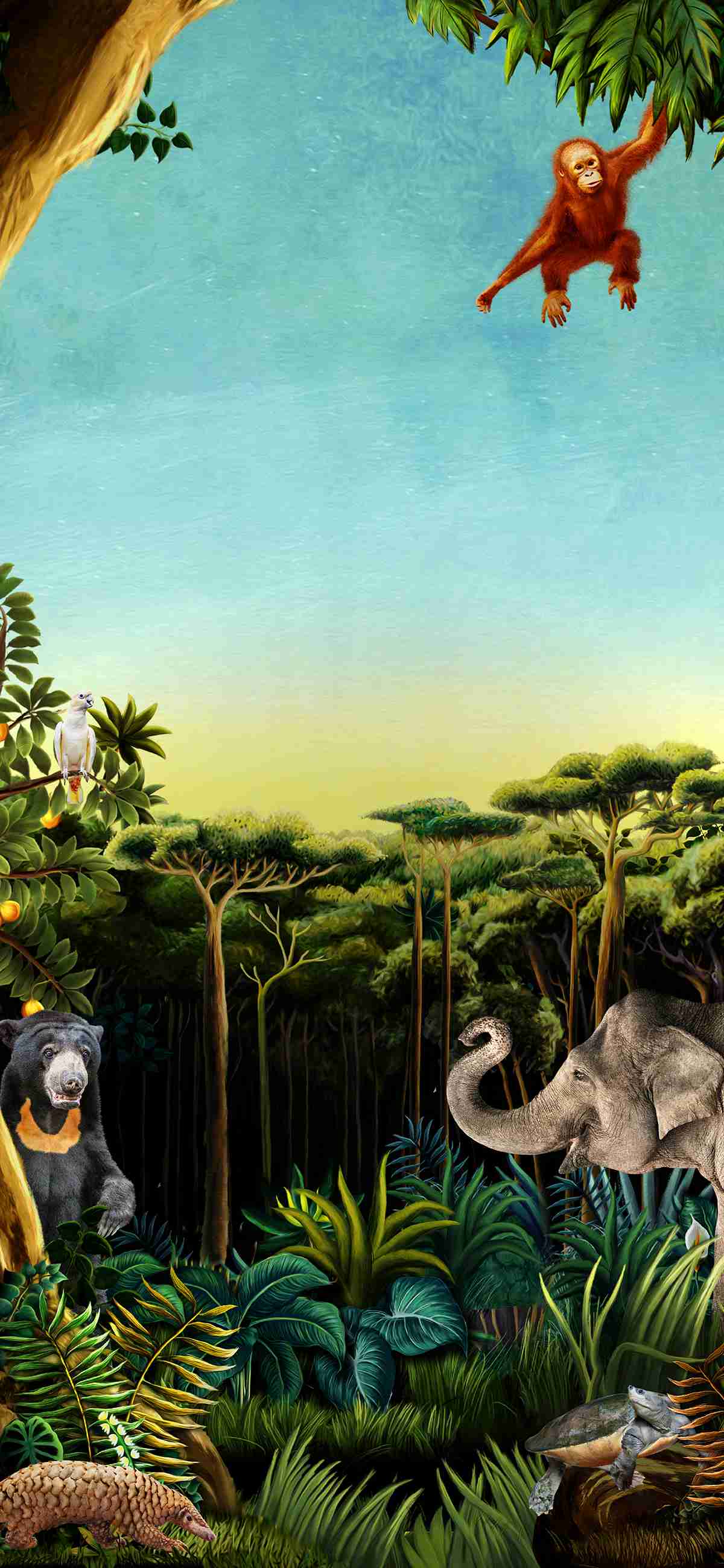Singapore Zoo introduces revamped elephant presentation
21 SEP 2018
Senior keeper Clement Bayang uses positive reinforcement to coax Intan to lie down in the water to demonstrate how the protected contact management system works. In the background, Assistant Curator Udhaya Kumar Kalirathinam encourages Komali to open her mouth to reveal her massive molar teeth to the audience. The water moat between the keepers and their elephants acts as a physical safety barrier separating elephant and keeper. Both elephants will subsequently receive a food treat as reward for participating in the activity.
PHOTO CREDITS: WILDLIFE RESERVES SINGAPORE

Jati blows out the popcorn to get at a favourite treat, demonstrating her reach in height as well as her problem-solving abilities. Beside her, Gambir takes a breather from the popcorn to explore some jackfruit leaves. Varied enrichment devices prepared by the keepers every day aim to keep the intelligent pachyderms stimulated both physically and mentally, and also serve to make the presentation an enriching experience for the elephants as well as the audience.
PHOTO CREDITS: WILDLIFE RESERVES SINGAPORE
Keepers will play supporting roles outside the exhibit, serving mainly to interpret the elephants’ actions to guests. Aside from introducing the audience to the elephants’ personalities and quirks, keepers will demonstrate positive reinforcement methods to engage the elephants and encourage them to display natural behaviours such as laying in the water or leveraging on a log to reach their favourite fruit. To make the show more interactive, a new volunteer segment has been included, where a lucky visitor will get to enjoy a close encounter with one of the modern day mammoths.
The reimagined elephant presentation, which will be officially launched tomorrow in celebration of Elephant Appreciation Day, is part of Wildlife Reserves Singapore’s (WRS) continuing efforts to provide world class care for her animals through improved animal welfare. It is also in line with WRS evolving the care of her elephants towards the protected contact elephant management system.
Protected contact management means there will always be a physical safety barrier between the keepers and the elephants, which allows caretakers to continue providing quality care for the elephants while ensuring a greater level of safety for both elephants and humans.
WRS first began laying the foundation for the protected contact system in January 2015, with the cessation of programmes involving direct visitor contact with the elephants, such as elephant rides. Since then, other steps towards implementing the protected contact system include allowing the elephants to free-range within their exhibit and stables at night, discontinuation of painting sessions and re-training the elephants and their keepers to the new system. These initiatives also create more opportunities for the elephants to interact amongst themselves and build stronger social bonds.
Dr Cheng Wen-Haur, Deputy CEO and Chief Life Sciences Officer, WRS, said, “The new elephant presentation is a clear departure from the former show where the keepers directed the elephants to perform certain actions. In the reimagined show, the elephants are given free rein to show off their range of natural behaviours and personalities. The idea is that elephants are amazing, engaging and interesting to watch just by being themselves.”
The new show format also represents a key step in WRS’ progressive implementation of the protected contact elephant management system. The complete implementation of the protected contact system will take another three to five years as it will involve major redesign and construction of the elephant exhibits and back-of-house facilities. Singapore Zoo and sister park Night Safari will be among the first zoological institutions in Asia to implement the protected contact management system for all their elephants. Among the modern zoo community, this method is currently deemed to be the safest way to manage elephants while ensuring proper animal care and welfare.
Currently, Night Safari’s two bull elephants are fully managed under protected contact. Two-year-old Neha, the youngest female in Night Safari, has also been conditioned under protected contact to allow vets and keepers easier access for medical procedures.
Visitors can enjoy the new elephant presentation at Singapore Zoo’s Elephants of Asia exhibit twice daily at 11.30am and 3.30pm and take part in elephant feeding sessions which happen after each show. Additional feeding times take place at 9.15am, 1.30pm and 4.30pm.

Senior keeper Ahmad Syarif Bin Aneng Rachmat hands Aprila a reward after an operant conditioning demonstration during the new elephant presentation. The stick that Syarif is holding in his left hand is a target tool that Aprila responds to during operant conditioning sessions, which are purely voluntary and stress positive reinforcement. Aprila participates at her own will and on her own time. When she does something correctly, Syarif blows the whistle to bridge the action, and presents Aprila with a reward – usually a favourite food treat.
PHOTO CREDITS: WILDLIFE RESERVES SINGAPORE

